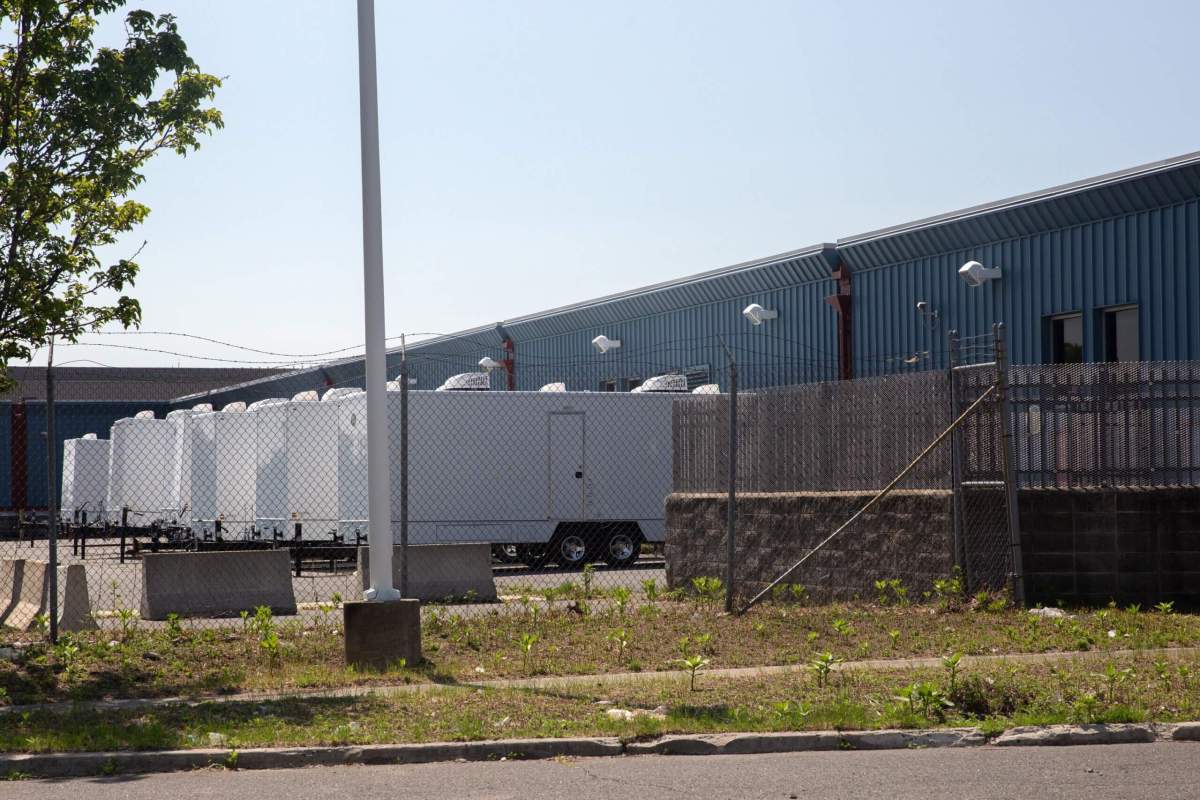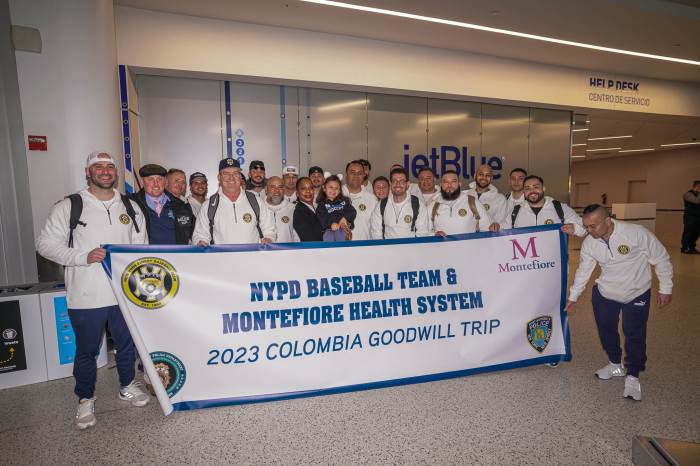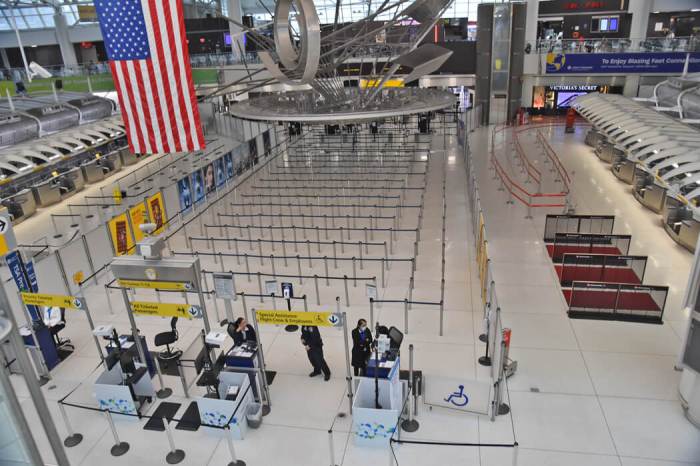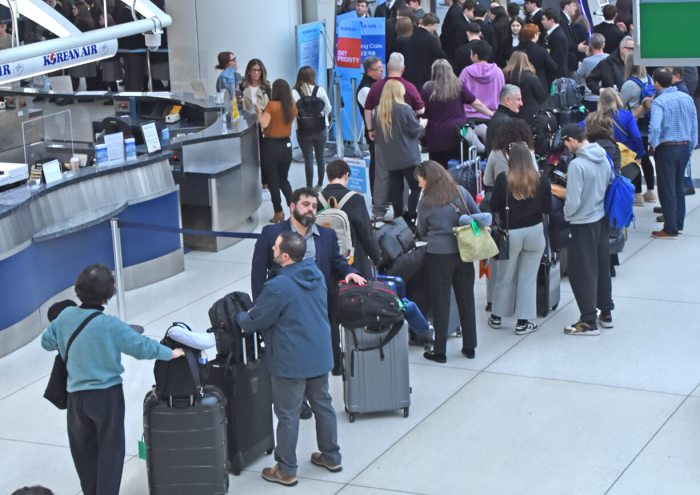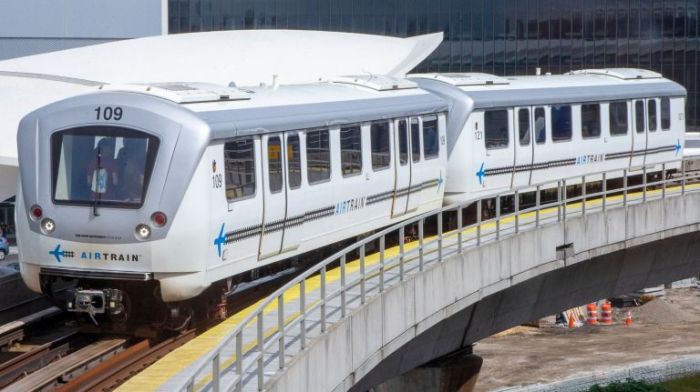This article was originally published on by THE CITY
Five hundred cots and several trailers with showers and bathrooms are in place at a sprawling warehouse at John F. Kennedy International Airport compound, THE CITY has learned, awaiting the green light from federal authorities to move migrants there.
City officials are expecting to place as many as 1,000 adult asylum-seekers in the cavernous JFK warehouse, beginning as soon as they receive approval from the Federal Aviation Administration, according to a source familiar with the operations.
Building 197, as it’s called, was used as an overflow facility for the United States Postal Service. It’s located along a desolate industrial stretch of highway, across from the barbed wire fence that girds the JFK airport tarmac. The nearest train station is the Locust Avenue Long Island Railroad stop — a 20-minute bus ride away.
/cdn.vox-cdn.com/uploads/chorus_asset/file/24696206/060123_jfk_migrants_1.jpg)
Despite initial indications that the number of arriving migrants is on the decline, the administration of Mayor Eric Adams is aiming to use the warehouse through the fall as it looks to consolidate people there who have been sleeping in smaller ad hoc shelters it dubs “respite centers.”
Facilities like those are less equipped for long-term stays and lack basic infrastructure such as showers, said the source, who was not authorized to speak to reporters.
‘More People Coming In’
The warehouse facility appears to be an attempt by Adams administration officials to resurrect a large-scale emergency shelter, similar to the one the administration stood up and dismantled at the Brooklyn Cruise Terminal and previously on Randall’s Island over the past several months.
A spokesperson for the FAA didn’t respond to requests for comment. Asked about the JFK warehouse, Adams spokesperson Fabien Levy declined to provide specifics.
“As we always say, all options [are] on the table,” he said. “We are hopeful we can find additional state and federal sites since, with more than 155 sites already open in New York City, we are out of space.”
The Port Authority of New York and New Jersey, which controls the airport, and Gov. Kathy Hochul’s office, had been involved in negotiations over the city’s use of the site, officials with both offices confirmed. Hochul had mentioned the potential use of a hangar at JFK at a press conference Tuesday, NY1 reported.
In addition to the JFK warehouse, city officials are preparing to open up the state-owned former Lincoln Correctional Facility just north of Central Park, also for adult migrants.
Power Malu, a community organizer with the group Artists Athletes Activists, which has been greeting migrants at the Port Authority since last August, worried scarce city resources were being put in the wrong place.
“Why are we putting our attention and our energy into finding more office space or more hangars, or correctional facilities when we have apartments that are vacant,” he said, pointing to the tens of thousands of apartments reported vacant across the five boroughs.
Advocates have questioned Adams’ repeated assertion that “there’s no more room at the inn,” pointing to around 1,000 vacant beds in homeless shelters and another 2,600 vacant supportive housing beds that could help alleviate some of the crippling backlog in the shelter system.
‘We Want to Get Out of There’
The airport warehouse is the city’s latest attempt to house arriving migrants reaching the five boroughs.
An additional 4,800 asylum seekers have sought refuge in city shelters over the past two weeks, according to data provided Tuesday, by Kate Smart, a spokesperson for Mayor Eric Adams.
That brings the total number of asylum seekers in a combination of hotels, respite centers, traditional shelters, humanitarian relief centers and upstate hotel rooms up to a total 45,800, about half of the city’s overall shelter population, which reached a record of around 95,000 people through Wednesday, according to data provided by Deputy Mayor for Health and Human Services Anne Williams-Isom.
As the number of arriving migrants ballooned surrounding the April expiration of a federal policy known as Title 42, the city scrambled to find places for people to sleep, standing up ad hoc shelters in vacant offices, gymnasiums, schools and churches.
City officials belatedly dubbed these new sites “respite centers,” essentially waiting rooms, which officials have repeatedly maintained are only intended for brief stays. Despite that, many migrants are now sleeping in them for weeks on end.
Enrique, a 28-year-old asylum-seeker from Venezuela who arrived in New York City in mid-May with his girlfriend, said living inside the former Police Academy gymnasium in Manhattan for the past two weeks hasn’t been easy. The lights stay on all night long, making it difficult to sleep, and the building’s showers aren’t separated by curtains so that people have to bathe right in front of one another.
“There’s no privacy,” he said. THE CITY is withholding his full name because he fears retaliation and was concerned about his asylum case. “We want to get out of there, to see if they can move us somewhere else, but so far nothing.”
Migrants across the city have reported an array of conditions, with people having to trek to nearby parks to shower there in a sort of “walk of shame” or waiting on planned meals that never arrive, leaving volunteers and neighbors scrambling to fill the gap.
‘A Country of Laws’
Several asylum-seekers told THE CITY they were grateful for the accommodations, however sparse. Juan Carlos, 29, from Venezuela, has been staying at a respite center in a vacant office building in midtown Manhattan on May 17 since it opened.
“I feel good there,” he said in Spanish. Carlos went nearly two weeks without showering before city officials arranged a system to allow migrants to bathe at the nearby Stewart Hotel, which is housing migrant families. “Now that they set up a way for us to shower, we feel so grateful.”
Carlos said he spent several days walking the city hunting for work before finding a job off the books at a fried chicken joint in the Bronx.
“I’ll start saving so I can rent myself something, thank God,” he said.
Mostafa Won, 32, an asylum seeker from Mauritania staying at a respite center in a vacant Catholic school in the East Village, said he had no complaints about his time there since arriving late last week shortly after it opened.
/cdn.vox-cdn.com/uploads/chorus_asset/file/24696418/DSC04195.jpg)
“They treat us well. We eat well, no problems,” he said in French. “Truly, 100%.”
Won said he’d fled his country after several of his friends were imprisoned for organizing against slavery and the military dictatorship there.
“I came to the United States because it’s a country of laws, where they respect human rights,” he said. “That’s my goal, to be in peace.”
/cdn.vox-cdn.com/uploads/chorus_asset/file/24696424/east_village_respite_center.jpg)
Neither the Humanitarian Emergency Response and Relief Centers, which the city began opening last fall, nor the newer respite centers, which the city started opening in May, are in strict compliance with longstanding rules that apply to traditional shelters. Traditional shelters aren’t supposed to have more than 200 beds, and beds have to be spaced at least three feet apart.
Last week, the Adams’ administration filed court papers arguing that the city needed even more leeway to skirt the city’s longstanding “right to shelter” system, asking a judge to suspend those rules altogether if the city runs out of “resources and capacity.”
The Legal Aid Society, which represents the Coalition for the Homeless in the decades-old case, has promised to fight the request vigorously in court.
‘Not Permanent Places’
At a press conference Wednesday, Zachary Iscol, the commissioner of the city’s Office of Emergency Management, confirmed THE CITY’s previous reporting that seven respite centers are currently in operation across the city.
“We took the model that we used…to open up coastal storm shelters and adapted that to provide a temporary place for us to shelter asylum seekers as they are waiting for placement in other facilities,” Iscol said. “I want to be very clear that these locations are not permanent places, they’re not long term [or] mid-term solutions.”
There are some early indications the number of new migrants arriving in New York City is on the decline, after the expiration of Title 42, which many had speculated would result in more border crossings. Instead, border crossings went down 50%.
Deputy Mayor for Health and Human Services Anne Williams-Isom said at the same briefing on Wednesday that 2,200 asylum-seekers had entered city shelters in the last week, a steep decline from the week prior when Mayor Eric Adams said 5,800 people entered city shelters.
Williams-Isom reiterated a common refrain from members of Adams administration, who for months have been calling for more funding from the federal government and for the Biden administration to expedite work permits for arriving asylum seekers.
“This city continues to do whatever we need to do to support the asylum seekers,” she said. “But we have reached a point where the system is buckling.”
THE CITY is an independent, nonprofit news outlet dedicated to hard-hitting reporting that serves the people of New York.



